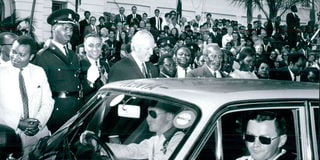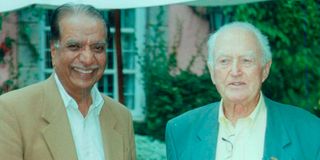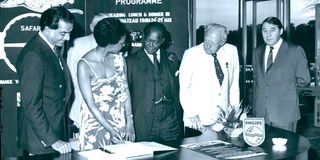Queen Elizabeth must be smiling up yonder due to Safari’s success

President Jomo Kenyatta accompanied by Safari Rally Chairman Eric Cecil and other dignitaries at the flagging off of the 1968 Safari Rally outside City Hall in Nairobi.
What you need to know:
- The Coronation Safari Rally was actually ahead of its time in many ways, thanks to Cecil’s innovations
In the second installment our two-part series looking back at Queen Elizabeth II’s influence on the Safari Rally, our motorsport correspondent PETER NJENGA looks back at the early days of the Safari Rally, an event inspired by the late Queen
In Thurday’s Daily Nation, we recalled how, in January 1952, “Bwana Safari” Eric Cecil, his cousin Neil Vincent and Eric Tromp were sharing a beer at a bar in Limuru, near Nairobi.

Eric ‘Bwana Safari’ Cecil (right) with long-time Safari Rally chairman Bharat Bhardwaj.
As the night wore on, Cecil and Tromp asked Vincent why he shunned Langa Langa.
“I can't be bothered running around in circles. But if you could organise an event where we get into our cars, slam the doors and go halfway across Africa and back and the first car is the winner, then I will enter," said Vincent, as Cecil told me in a 2002 interview for the Daily Nation.
Two control points
This simple statement led to the birth of the Safari Rally.
Cecil's mind went on a spin and several mugs of beer later, he suggested a trip around Lake Victoria: Drivers would choose any direction to start with only two control points near Bukoba.
Though corruption was non-existent then, Vincent rejected the idea to avoid cheating, especially at the ferry crossing area.
They needed a rally that would test the stamina of man and technical potency of car.
It would be exciting to try and Cecil finally settled for rallying.
Cecil returned to the EAAA and sold the long distance event concept but the bosses were not interested. They considered EAAA as a body solely to serve the motoring public and not motorsports fans.
“They told me that they were not interested,” Cecil told me in an interview at the exclusive Muthaiga Country Club several years ago when he came to Kenya as a guest of the Safari Rally.
“But God presented me with a gift," he added. Cecil returned to the EAAA in February, 1952, days after Queen Elizabeth received the news of her father's (King George VI) death while, incidentally, in Kenya, lodging at the Treetops in Nyeri.
“Please do allow the motoring public in Kenya to commemorate the coronation of the Queen through a long distance event,” Cecil pleaded with the EAAA.

Left: Attorney General Charles Njonjo (third left) opens the 1980 Marlboro Safari Rally Week desk at the Inter-Continental Hotel, Nairobi. Looking on are Bharat Bhardwaj (left), Chairman of the rally, Alice Muya of the Inter-Continental Hotel and Eric Cecil.
Kenya was a British colony and the EAAA had no alternative but to give in to Cecil’s request.
But he was told to look for money elsewhere. Conscious that competing in rallies costs money and many could not afford even the relatively small cost of that time, he came up with a raft of innovative ideas.
He wrote to the RAC (Royal Automobile Club) in England, the governing body of motor sport in East Africa, requesting advertising on competing vehicles to attract sponsorship for the drivers.
This was denied, but in subsequent telephone conversations, chairman-to-chairman level, Cecil emphasized the need for some assistance and went ahead of his own accord to look for sponsors.
The first were the East African Standard newspapers, Shell Oil Company and East African Airways. The Coronation Safari Rally became a reality.
Cecil’s innovations
Commander Eric Cecil, best known in Kenya as “Bwana Safari”, attended every Safari since he first organised it in 1953, an event which he later conducted as the chairman of the organising committee for 21 years while serving as the AA (Automobile Association of Kenya) chairman for 35 years.
It is interesting to note that Cecil, in his DKW Auto Union (forerunner of the Audi), together with Tony Vickers as navigator, was the outright winner of the Safari in 1956.
The Coronation Safari Rally was actually an event ahead of its time in many ways, thanks to Cecil’s number of innovations such as competition cars divided into four categories of entries on the basis that “you got what you paid for.”
Secondly, competition numbers on the roof of the vehicles were first introduced in the Safari so that they could be identified from the air.
With Alex Noon, a famous aviator at the time, Cecil and, later, broadcasting icons like Bob Dewar and Sammy Lui Wang’ombe gave the first air-to-ground commentaries through (Kenya Army) Forces Broadcasting Services in Nairobi (call and wireless).
Ahead of their time
Fast forward and a record 63 foreign journalists come to Kenya ahead of Madaraka Day in 1963.
“Jomo called me and told me: 'you are Bwana Safari from now,’” Cecil told me in our 2002 interview at the Muthaiga Club, an exclusive place where photography is not allowed.
From then on, the Safari became a state function.
We should salute Mzee Dewar and Sammy Lui Wang’ombe.
They did what the WRC Promoter is doing today through live broadcasting of the World Rally Championship from helicopters.
Well ahead of their time.
Dewar was awarded the FIA Award for Heritage last year.
In 2022, some 70 years after Cecil conceived the Safari, the event is back in the World Rally Championship and with Kenyan drivers competing at the highest level of competition.
Queen Elizabeth II must certainly be smiling up yonder!
Njenga is a long-serving Daily Nation motorsport correspondent. [email protected]




